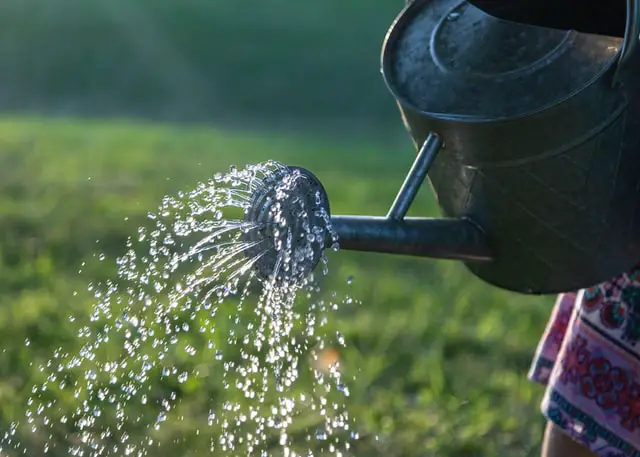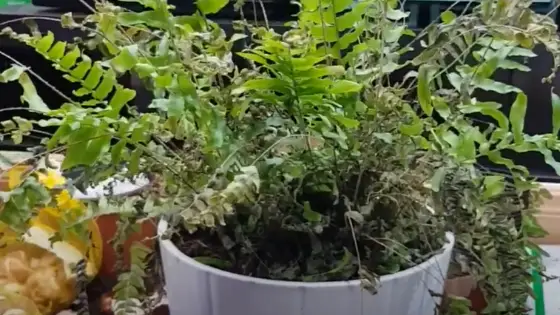You are asking yourself, “Why Are My Fern Leaves Turning Brown?” That’s not good, and it’s time to find out why. No more worrying about your fern (or any fern) going extinct. Let me show you why this might be happening, how to fix it and where to get the best ferns around!
Table of Contents
Why Are My Fern Leaves Turning Brown? Root Issues and Possible Remedy

When the leaves on your houseplants start to turn brown, it’s usually a sign that something is wrong. Early diagnosis of the problem is crucial because if it isn’t fixed in a timely manner, it might swiftly start to destroy your fern.
We’ll go through each of the major reasons why a fern’s leaves become brown in this post, as well as offer advice on how to fix the problem and keep it from getting worse in the future.
The most typical causes of browning ferns are a lack of humidity, excessively bright light, watering problems, and excessive fertilization. The first issue is by far the most widespread and can be resolved with the least amount of effort. There is one factor that can result in browning of the fern leaves; however, this is not necessarily a reason for concern because a certain amount of browning on the foliage can be considered typical.
This is simply an indication that your plant is growing. In the following paragraphs, we will discuss how to determine if the reason is normal or a cause for concern, as well as what signs to look for to make that determination.
Read more: Why is Your Asparagus Fern Turning Yellow
Brown leaves can be caused by a lack of humidity
If your home has a tendency to have dry air, it may be worthwhile to attempt to slightly raise the humidity because ferns like a more humid atmosphere. As the fern’s leaves are so thin and sensitive, they will soon get dehydrated when exposed to dry air.
On houseplants with larger leaves, the browning of the tips or edges of the leaves is typically the sole symptom that results from insufficient humidity. However, due to their thin, frequently tiny leaves, ferns can be significantly impacted by dry air, thus it’s critical to take action as soon as possible when this occurs.
There are a few relatively easy strategies you can use to maintain a higher-than-normal humidity level for your plant, and it’s a good idea to start using them regularly. This will stop any further browning of the leaves on your plant that could have occurred.
First, spraying your Fern with a spray bottle is the technique we advise utilizing the most. You should be doing this on a daily basis while you are working to cure the problem, and then you should reduce the frequency to once per few days after the brown leaves are under control. Your plant will benefit from this in a number of ways, including receiving a good boost in growth and avoiding drying out of its leaves and stems.
Use of a pebble tray is the second approach, which is incredibly good. Before you can even get started, there is some additional do-it-yourself work that needs to be completed, but your Fern will be eternally grateful to you. Put your plant on top of a pebble tray that is half full of water.
Read more: Can Boston Fern Grow In Water?
Water will evaporate around your plant over the day, preventing the leaves from drying up. When utilizing this strategy, however, taking care not to overfill the pot with water is of the utmost significance. Your Fern should not be left submerged in water for an extended amount of time.
There are a few techniques that involve a lot less effort if you frequently forget to mist your Fern or if you do not want to make a pebble tray for it. You should probably put your plant in the bathroom if it receives a lot of natural light there because it is the best environment for it.
As a result of the steam produced by showers, the amount of humidity that can be found in bathrooms is often a little bit higher than it is in a lot of other rooms. This indicates that you do not need to make any adjustments to the normal care you provide your Fern in order for it to flourish in a lovely humid atmosphere.
Investing in a humidifier is another fairly passive technique to ensure that the humidity level is high enough for your Fern. These little, inexpensive devices work wonderfully at keeping your Fern from sprouting any more brown leaves and are fantastic at attaining and maintaining a healthy humidity level.
This humidifier, which can be purchased from Amazon and is also really reasonably priced, is a big hit with our ferns. If you want to get a bit fancier, there are humidifiers that run on timers, so you don’t even have to bother to switch them on!
If you’re not sure whether humidity is an issue for your Fern, or if you’re not sure when you’ve achieved a proper humidity level, you can always get a decent humidity meter to keep track of things and ensure the air isn’t too dry.
Because air conditioner systems and radiators both produce extremely dry air in a home, the first step you should take is to move your Fern away from these sources of dry air.
Read more: Asparagus Fern Propagation – A full Guide
Intense light might also cause your Fern’s leaves to turn brown
Indoor plants, in general, benefit from adequate lighting, and ferns are not an exception to this rule. The fact that your Fern’s leaves are so very thin and delicate means that they are particularly sensitive to shifts in lighting conditions.
Because ferns are rather susceptible to burning and drying out in harsh light, you’ll see the tips of the fronds beginning to turn brown if your plant is receiving too much bright light.
Even if the browning of the leaves is now permanent, it is not difficult to stop other instances of the condition from occurring. All you have to do is move your plant to a little shadier location. You don’t want to make a huge adjustment and put your Fern in the darkest part of your home all of a sudden, but you do want to move it away from the direct light. Just keep away from the direct sun’s rays and make sure your plant is still receiving enough of indirect sunlight each day.
During the winter, you may place your plant closer to the window and it won’t matter as much if it gets direct sunshine. This is due to the sun being more weaker and shining for a shorter period of time throughout the winter.
We strongly advise you to make use of a light meter in situations in which you are unsure about the amount of light that your Fern receives in its current location (or in any other locations in your house). They will describe the amount of light that is present in your house during the day, and you will be able to see how it changes over the course of the year.
Read more: Asparagus Fern Care – A Complete Guide
Brown leaves may suggest a watering issue.

As with many things in the houseplant world, regular watering is an important piece of the jigsaw, and watering your Fern far to much, too frequently, or too little can all cause to issues, including brown leaves.
If you feel that there may be a problem with the amount of water being used, the first thing you should do is check the soil. Carefully take your Fern from its container and inspect the potting mix to determine if it is waterlogged or extremely dry. Ferns despise very dry soil, but they may also rot if the potting mix remains saturated with water for an extended period of time, so finding the optimal moisture level for them is essential.
The root system is another item to look at once you’ve removed your Fern from its container. If the rots have begun to crisp up, this is an indication that you’ve been underwatering for a considerable amount of time. If, on the other hand, the roots have become fairly black in color and are mushy to the touch, this is an indication that your Fern is suffering from root rot as a result of the soil becoming extremely moist.
You may also use the finger and chopstick method to determine how wet the soil is if your Fern is too fragile to be taken from its pot. This method involves using your finger and a chopstick. Make a hole the soil with a chopstick or one of your fingers about an inch deep. If the test comes out clear, this indicates that the potting mix is on the dry side.
You can be overwatering if the potting soil is completely covered when it comes out. You may also examine the soil with a moisture meter to get a more precise measurement and to determine with absolute certainty when it is the appropriate time to water your plants.
Read more: How Often To Water Ferns
How to correct watering and avoid brown leaves?
If you notice that the soil is excessively dry, water your plant for around 15 minutes. You don’t want to submerge it completely in water since doing so might cause it to go into shock; instead, give it a little soak so that it can absorb some of the water. After that, water the plants very slightly once a day for the next week to prevent a sudden change in the environment.
Since most ferns have rather deep root systems and typically come with a lot of peat moss in the container, it may be very challenging for water to pass through when they’ve dried up.
You must make sure you are watering often enough to prevent the soil from drying out for too long if you want to avoid future problems like brown leaves caused by underwatering. A self-watering container is the solution for you if you frequently forget to water your fern.
It will provide the proper amount of water to your plant without you even having to be present! This one, which can be purchased from Amazon, is very highly recommended by us.
To completely change that potting mix, though, if overwatering has been the issue and your fern is resting in soggy soil. It is important to remove as much of it from the roots whenever you can without causing further damage to the root structure.
Read more: Is My Fern Dead? 6 important signs and how to be sure
To help the plant begin its healing process and avoid more brown leaves, replace with new dry mix. In addition to this, you should cut away any rotting roots. These cannot be saved, and pruning them will stimulate the plant to produce more.
To achieve lovely even hydration in the soil, we’ve always gone for a little and frequently approach to watering our Ferns. They don’t like to go from one extreme to the other, which is another reason why leaves can turn brown.
We advise pulling up your fern both when it needs to be watered and after you have done so. By lifting your ferns, you can get a sense of when they might need a bit more water.
You may also prevent watering problems and the resultant browning of the leaves by taking a few additional preventative measures, particularly with regard to drainage and waterlogging of the soil. We frequently purchase houseplants in plastic containers. Due to their small weight, low cost, and unbreakability, they are excellent for plant stores and nurseries.
However, because they retain every drop of moisture, they aren’t always the ideal choice for our cherished plants. This means that it’s easy for the roots to start to rot if you overwater the plant by accident or if the drainage holes are blocked by something.
Terracotta pots, on the other hand, will enable some of the extra water to drain out of the edges of the pot, which will benefit your Fern. Even though they cost a little extra to purchase, they are unquestionably an investment that is worthwhile since they may be a true lifesaver when it comes to watering problems.
Read more: Lace Fern Care – A Complete Guide
Beware of over-fertilisation

The dosage recommended by the majority of generic plant feeds and fertilizers is generally far too high for ferns and can cause browning of the fronds.
Each houseplant is unique, and there are several elements that influence how much fertilizer your plant will require. Your plant’s nutrient requirements can be affected by a range of factors, including its size, location, maturity level, and variety, as well as environmental factors like the amount of light and temperature it receives. This is why a one-size-fits-all quantity, as suggested by many fertiliser packages, is unrealistic.
For most plants, we frequently advise using less than the suggested quantity, but because ferns have such fragile leaves and stems, this advice is particularly important. Browning can be caused by even the tiniest amount of over fertilization.
The best course of action in this case is to feed your Fern at half the suggested amount and observe how it responds. If you observe any browning, flush the feed with extra water and try again with a quarter of the dosage the next time you water.
If you don’t want to risk damaging your Fern, you can completely exclude fertilizer from your care routines. In point of fact, we suggest that you do this for a few months in order to give your plant some time to heal, but it is entirely up to you to decide whether or not you want to continue doing it in the future. You don’t need to use fertilizer to have a lot of healthy new growth!
Read more: Plumosa Fern Care – A Complete Guide
It is natural for your Fern to have some brown leaves
In spite of the fact that all of these concerns have been problems that have caused your Fern to produce brown leaves, there is one more element to consider that is not too frightening at all, and that is natural aging.
As your Fern ages, it will prioritize developing new growth over part of its older growth. This is something that happens with the vast majority of other houseplants as well. This is due to the fact that as it grows, it will desire to produce larger leaves in order to increase photosynthesis.
As this happens, some of your plant’s older leaves may fall off, but they will likely turn brown first. This is an entirely normal procedure that frequently occurs in the case of ferns.
However, you might be asking how you can tell the difference between the effects of normal aging and other, more significant issues. First, we suggest making sure none of the aforementioned is the problem. You should examine the soil and keep a close eye on all of the environmental parameters to see if you can identify anything that might not be functioning properly. The next step is to examine your plant to check if it is sprouting new growth.
Natural aging is indicated if your fern is producing a lot of young, healthy stems and leaves while losing some of its oldest and lowest leaves. You shouldn’t have any cause for concern as long as your Fern is adding new leaves at a faster rate than it is dropping old ones.
Read more: Foxtail Fern Care – A Complete Guide
Conclusion
Why Are My Fern Leaves Turning Brown?
We really hope that you have found our guide on diagnosing and treating brown leaves on a Fern to be helpful, and that it has enabled you to determine what the issue is with your plant. In general, the problems with ferns becoming brown are simple to identify and should not be too difficult to begin resolving.
However, recognizing the problems early on, before they have really gotten a grip of your plant, is the key to giving your Fern a second chance at life. In order to identify any problems early, we always advise giving your plants frequent checks.
Photo by David Ballew on Unsplash
Uncertain photo created by wayhomestudio – www.freepik.com
Man showing photo created by wayhomestudio – www.freepik.com


